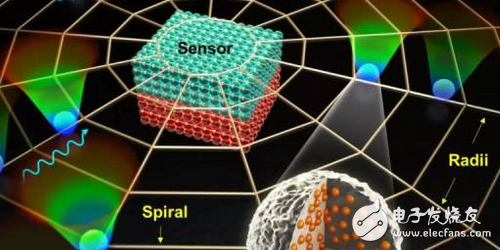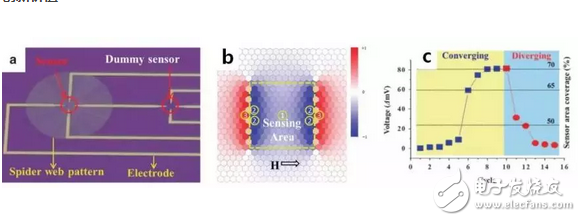The research team of the Daegu Gyeongbuk Institute of Science and Technology in South Korea has developed a new integrated biosensor chip lab platform that uses the spider web micromagnetic pattern to be 20 times faster than existing biosensors. This technology can be applied to the early diagnosis and recurrence diagnosis of diseases such as cancer. Innovative background To better understand this innovative research, I started with biosensors. Biosensors, as the name implies, are sensor devices that are sensitive to biological substances and that convert concentrations into electrical signals for detection. Its composition consists of identification elements, ie immobilized bio-sensitive materials (including enzymes, antibodies, antigens, microorganisms, cells, tissues, nucleic acids and other biologically active substances), appropriate physical and chemical transducers (such as oxygen electrodes, photosensitive tubes, field effects). Analytical tools or systems consisting of tubes, piezoelectric crystals, etc. and signal amplifying devices. However, perceptual power is a very important performance indicator for biosensors. It is determined by the "resolution" of the sensor and the "molecular movement and reaction rate". Research groups in many countries, including South Korea, have increased the resolution of biosensors by developing nanomaterials. However, the sensitivity of the sensor is still limited, because the diffusion rate of the biomolecule is relatively low when it is transmitted to the sensing area. Therefore, the current bottleneck is simply: Biomolecules such as proteins and DNA are slow to move because they only rely on diffusion for transmission. Innovation exploration Schematic diagram of a spider web-like biosensor platform In the face of challenges, the research team of the Daegu Gyeongbuk Science and Technology Institute led by Professor CheolGi Kim has made innovative explorations in this area. Let's take a look at their results. The research paper was published in Nature Publishing Group's Asian Materials magazine, and it is also an international academic journal. The researchers were supported by the BioNano Health Research Group and the Center for Plasma Biosciences of the Korea Ministry of Science, Information Technology and Future Planning. They developed a chip-in-a-chip platform that integrates biosensors, which is 20 times faster than the biosensors that use spider-like micromagnetic patterns. These biomolecules are labeled with superparamagnetic particles and applied with an additional electromagnetic field that allows the movement of these biomolecules to be easily controlled and easily detected by ultrasensitive magnetic sensors. Core Technology Biosensor using a magnetic swimming spider web a. Schematic diagram of a magnetic spider web with integrated sensors b. Magnetic spider web scanning electron microscope image of integrated sensor c. Representative layered schematic diagram of the sensor and magnetic pattern in Figures A and B The research team developed the new biosensor platform using a spider-like "micromagnetic pattern." It improves the sensory capabilities of biosensors because: It attracts biomolecules labeled with superparamagnetic particles to the sensing region, improving the ability to acquire low-density biomolecules. In this regard, the first author of the paper, Byeonghwa Lim, is also a Ph.D. in biosensor platform research at the School of Emerging Materials Science of the Daegu Gyeongbuk Science and Technology Institute. He said: “We placed a micro-magnetic field pattern in the shape of a spider web, moving the superparamagnetic particles towards the center of the platform's sensors and high-sensitivity sensors. When a rotating magnetic field is applied to the spider web magnetic pattern, the sensor can quickly attract the mark with superparamagnetic The biomolecule of a particle, which moves very fast and is 20 times faster than the diffusion test method." Innovative value Sensor measurement signal a picture of a magnetic spider chip integrated with a magnetoresistive sensor b. A stray magnetic field image based on the particle position effective associated with the sensor sensing area c. Measured sensor signal The research team also successfully used biosensor platforms to detect biomolecules paired with superparamagnetic particles at a distance from the sensing area. In addition, the team has identified superparamagnetic nanoparticles that not only play the role of transporting biomolecules, but also serve as labels to enable sensors to identify the location of biomolecules. Professor Jin said: “Existing biosensors take a long time to detect low-density biomolecules and lead to low transmission efficiencies because they rely only on diffusion. Magnetic field-based biosensor platforms not only improve the acquisition capacity of biomolecules, It also increases the speed and sensitivity of biomolecular movements. Therefore, we plan to use this platform for early diagnosis and recurrence diagnosis of diseases such as cancer." Value The biggest value of the application of this innovative technology, as described by the researchers, is the early detection of diseases such as cancer. Because of its speed, it greatly reduces the time cost of diagnosis and is more rapid. Diagnose diseases to better benefit human health. Solar Home Lighting System Kit SHENZHEN CHONDEKUAI TECHNOLOGY CO.LTD , https://www.szsiheyi.com

